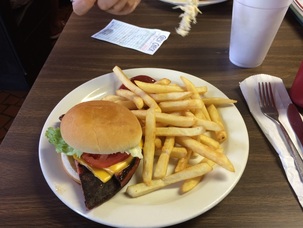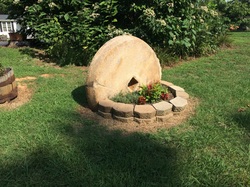 You could probably find a better fried bologna and cheese if you looked hard enough, but if it was me I would just eat the one at the Village Restaurant in Denton and be happy.
You could probably find a better fried bologna and cheese if you looked hard enough, but if it was me I would just eat the one at the Village Restaurant in Denton and be happy. I had in mind one thing when I left Denton, just east of Salisbury and the Yadkin River: Archaeology. I was interested in archaeology, because I knew I was going to pass by the site of Keyauwee Town, the site on the Caraway Creek of not only the Keyauwee Indians Lawson visited (though uncertainty remains about the exact location of that town) but of the dawn of scientific archaeology in North Carolina. In 1933, one Joffre Lanning Coe, born and educated in North Carolina, attended the first meeting of the Archaeological Society of North Carolina, whose president, Douglas Rights, was the dean of the nascent North Carolina study of archaeology. It was Rights, in fact, who in 1931 published the article "The Trading Path to the Indians," which included a first attempt to figure out Lawson's path. In 1947 his book The American Indians in North Carolina contained "Lawson's Long Trail," a chapter that detailed the trail in far greater depth, as far as Rights could trace it; until I met Val Green, I thought Rights was as close as I was going to get.
Anyhow, so as I left Denton I was excited to be heading off to not only Lawson's history but the history of NC archaeology. I had made arrangements with Delk's Army-Navy Surplus Store, possibly the greatest surplus store in the world, to set up camp on their front lawn, which I had only seen on Google Earth. It was within a quarter mile of the Keyauwee site, plus it was a good day's walk from Denton. I got the always-helpful Katie Winsett to drop off my camping stuff there; we had left my car in Julian, NC, where I expected to finish a day later, and I bought Katie lunch at the Village Restaurant in Denton. If you learn nothing else from this website, please learn that you should go to lunch someday at the Village Restaurant in Denton.
Lawson speaks of visiting the Keyawees a day after leaving the Sapona, and finding a town that he says that "Nature hath so fortify'd this Town, with Mountains, that were it a Seat of War, it might easily be made impregnable; having large Corn-Fields joining to their Cabins, and a Savanna near the Town, at the Foot of these Mountains.... And all this environ'd round with very high Mountains, so that no hard Wind ever troubles these Inhabitants." He says it's 5 miles northwest of the Uwharrie River (he calls it the Heighwarrie), though that turns out to be a misprint: on Caraway Creek, almost exactly 5 miles northEAST of the Uwharrie, flows the Caraway Creek.
There on the Caraway the society believed it had in 1936 found part of the Keyauwee Village mentioned by Lawson, after members had begun digging there a year before. (Much of this story as I relate it comes from discussions with professor Stephen Davis at the University of North Carolina, or from the book he coauthored, Time Before History: The Archaeology of North Carolina.) The spot sits on the river, with plenty of farmland spreading as Lawson describes, and the Caraway runs right through the Caraway Mountains, the northern branch of the Uwharrie Mountains, supporting Lawson's description of the spot's protected environs. Lawson also describes the food provided to some of his party: "Two young Fawns, taken out of the Doe's Bellies, and boil'd in the same slimy Bags Nature had placed them in, and one of the Country-Hares, stew'd with the Guts in her Belly, and her Skin with the Hair on. This new-fashion'd Cookery wrought Abstinence in our Fellow-Travellers." I was glad I'd enjoyed the fried bologna at the Village.
 This isn't Mr. Harris's millstone, but it wasn't far from where he and I talked. Such stones are common here -- relics of the time when these creeks and rivers were the power source that made meal or flour of everybody's grain.
This isn't Mr. Harris's millstone, but it wasn't far from where he and I talked. Such stones are common here -- relics of the time when these creeks and rivers were the power source that made meal or flour of everybody's grain.  This is from Coe's report on the excavation at the Keyauwee site. Those are graves up at the top.
This is from Coe's report on the excavation at the Keyauwee site. Those are graves up at the top. But lost roads are the way of things. "That was a big thing in these areas," he says. "Everyone went to the watermill to get their wheat and corn ground. Then the power come, and they all shut down and everyone went into town." His aunt, born in 1918 but still sharp, tells him stories. "She was born back in there, and she told me of all the people that lived down in there."
Though he doesn't think his last name is connected to Mr. Johnson's first name, Mr. Harris liked the fact that he is a Harris and his wife is a Johnson -- "she's a double-barrelled Johnson," he laughed. "When they got married they didn't even have to change their name!"
In all my reading about the Caraway site of Keyauwee Town I have learned that the site Coe excavated was likely not the exact site of Lawson's visit. The graves they found at the site show virtually no signs of the trade goods that demonstrate contact with Europeans: beads, axeheads, iron goods, and so forth. "But they had one pit they excavated that had glass beads in it," said Stephen Davis of UNC. "So it's the best candidate. We have nothing else to rival it, and the material evidence from the site, you could argue that it has artifacts that date to that site."
Anyway -- the point for me was that just as Coe was doing archaeology at the Keyauwee site, so was Mr. Harris at his old mill. Finding the evidence -- road depressions, millstones, the safe, the pocket watch back. Checking the stories -- his aunt, his wife, the library, Raleigh. The story of the place lives in those road beds, those deeds and plats, those millstones and safes and pocket watch backs. Those empty house places tell a story of how the land was once, and the new cabin he's built tell a new story. And someday, one presumes, a new deed and entry in the plat book will show how a piece of land has a road easement, and the ghost road the state abandoned will reassert itself, a century later
| One more thing. Here's my campsite at Delk's -- possibly my championship weirdest and coolest campsite on the whole Trek so far. Delk's was very kind to me, and though their yard was a bit like a junkyard (including open 55-gallon drums serving as mosquito breeding tanks), I loved camping here, even when someone who didn't get the memo came roaring up to my campsite in a pickup at about 9 pm, assuring me that oh no I WASN'T camping on Delk's front lawn. A quick phone call of course resolved that, and no harm done, and he roared off again. Still -- when I dropped off my stuff early in the day, there had been a truck with a helicopter chassis loaded on it parked there, and I was going to camp between it and the rest of the yard, lightly sheltered from the all night Route 64 traffic. Delighted by the chopper, I spent all day thinking up |


 RSS Feed
RSS Feed